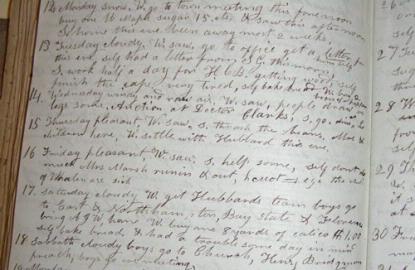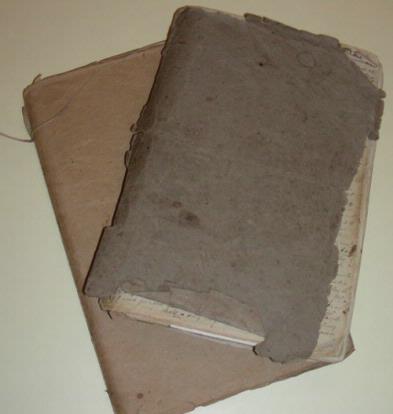
Editor’s Note: Compelled to learn more about how people survived New England winters before electricity, central heating, and supermarkets, I asked Barbara Pelissier, the president of the Westhampton Historical Society and Vice Chair of the Pioneer Valley History Network, to share some of her reading on the subject from local primary sources. She generously supplied the following excerpts, most of which come from the diary of Lydia Niles, of Westhampton, MA, covering the years 1855-1873.
Early October. “Dig the last of the potatoes and onions. Go chestnutting. Fix spokes on farm wagon. Go to Easthampton to sell potatoes, apples and chestnuts. Make cider, butcher hog and make mince meat out of the piece of hog’s head. Self clean pantry. Hung 12 heads of cabbage in cellar. Refilled husk bed. Strip tobacco. Put on bed quilts. Bank house.”
Winter was still a few weeks away. No snow yet. But on Nov. 28, 1855 Charles “Wesley” Niles, in his early twenties, was busy with the annual tasks of banking his home’s foundation, moving the small stove from the back room into the parlor, cording the bedsteads, and making sure the animals had sufficient shelter for the cold months ahead. His mother’s to-do list included: “Get bark in swamp to color the comfortable (quilt).” She spent her evenings embroidering undershirts and knitting stockings.
Winter in Westhampton, Massachusetts. By Dec. 12th, the weather had turned cold. “No sleighing yet.” “A negro lectured on slavery at Town Hall” in the evening five days later. Wesley paid 25 cents to attend. His mother cut out some blue wool to make him new pants. She made a nightcap for herself that same day. Pails and pans were mended. Wesley skated on Lyman’s pond.
On Dec. 26th, his mother, Lydia Niles, wrote: ”This Wednesday there is a thin icy mantle over the ground and every twig, tree and limb is covered with silvery sparkling diamonds which boreas come along the hills and dales, weaving and bending the forest trees. Makes it seem that winter is truly here now. Wesley been ‘round upon skates to town, down to Williams Edwards’.” Jan. 10, 1856 “It is terrible cold. Frost been on the windows two days. Cold as ever tonight.” Jan. 17, 1856, “Self knit mittens. Lima [Lydia’s daughter] cut carpet rags. Wesley work in mill.” Jan. 29, 1856, “The express driver, Jonathan Pitcher, took me through the snow drifts over to Huntington. Arrived there about eight in the evening, tax 37 ½ cents. Soon found myself seated in Mariette Lindsey’s sitting room, warm and comfortable. Stay’d all night.” Feb 2, 1856. “Sabbath. Cold! Cold and drift, too! Took a lock of hair of family.”
Stoves were moved out on April 7th. Spring arrived on April 18, 1856, when the “ladys of Westhampton got up a sugar eat at the town hall.”

________________________________
“There are few things in life – more especially in domestic life – that have a marvelous effect in agitating the inner man so as to make the entire interior and exterior individual appear quite ridiculous and feel still more miserable. Among these hideous causes are cording bedsteads, putting up stoves and stove pipe, putting down carpets, cleaning carpets and such little affairs. Blast them! How vexed a man gets while twisting away on the bed cord, when snap she goes! And tugging away on the carpet to make it fit when it won’t fit; and trying to make sections of stove pipe come together, when there is no more yield to them than there is to a pair of tongs…”
–November 6, 1866. Gazette
_______________________________
That invention has sympathy with mothers rather than with fathers, is perhaps shown by the fact that no one has yet produced from the depth of his inner consciousness a machine for putting up the refractory stovepipe, a duty that belongs peculiarly to the men folk, and with which they will, doubtless, be obliged to struggle until some one finds out a way of flying in the air or invents an umbrella whose stick – I do not mean the one carrying it – does not occupy the best place under it.
In one instance, however, inventive genius has been kind to fathers in the manner of putting up bedsteads. This generation may not have any recollection of the aerobatic achievements accomplished by an agile man in properly putting in order a bedstead that had cord to sustain the mattress or bed, instead of slats or wire. It was an effort from the start, in which the best judgment and the greatest activity were necessary to get the bedstead fixed so that it would stand firm, ready for the cord or rope. If you had successfully coaxed the end of one side into one post, it would certainly fall out while you were at work at another corner, and even if you had got round to the final corner, an unlucky move would pull the whole thing apart and drop it, sides, foot and head, in a heap on the floor.
Even with the posts all firmly set and the sides screwed in, the end was by no means yet. Stringing the cord or rope through the holes in the sides and then crossing them from the head to the foot, the real amusement and interest began in tightening these cords. You could only do it by getting up with your feet, grasping the next row of cord with both hands, and pushing and pulling and dancing around like a martyr tossed about on a red-hot gridiron, until the tension was complete.
Blessed be the man who thought of the little catches or iron slots that drop into the holes in the posts and hold the sides there without bolt or wrench to fasten them, and blessed still more the man who thought of the elastic slat to put in place of the tough but springy bed cord. He was as much the benefactor of his race, in degree or kind, as the one who gave us the locomotive or the cotton-gin.
— The American Magazine Vol. 23 (1887)
Photographs of Lydia Niles’s diary by Barbara Pelissier


